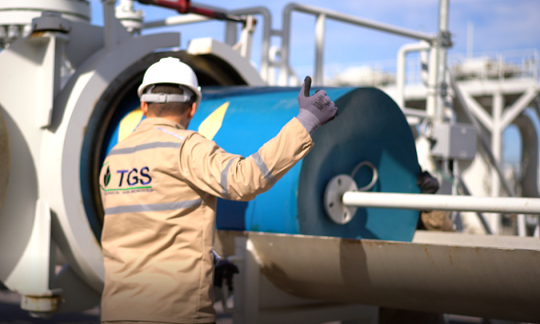Pipeline inspection is considered one of the periodic inspections implemented on the pipeline to determine its technical condition and ensure its effectiveness to transport gas with minimum risks.
Periodic time plans are set to inspect the network lines and coordinate with customers to agree on the necessary arrangements for carrying out the inspection work and making the required repairs and maintenance to the pipes.
The inspection process is executed by placing cleaning brushes into the pipeline through the launch/inlet trap at the beginning of the line, propelling the brushes through the pipeline path until the reach and are removed at the end of the pipeline from the receiving/outlet trap.
Several types of brushes are used to clean the pipelines, such as (Foam Pigs & Brush Pigs) to remove sediment and some welding work remnants of the newly constructed pipeline. The brushes are also used for pipeline dewatering after a Hydrostatic Test; moreover, the necessary tests are carried out to ensure the line's ability to be inspected with the smart brush before propelling it.
TGS uses internal inspection technique ILI (In-Line Inspection), in which the smart brush is propelled into the pipeline to complete the inspection process without stopping the gas flow through the pipeline.
TGS maintains operational conditions of the pipeline such as the gas flow rate, where the gas velocity must be steady throughout the pipeline and within the permissible operational limits to successfully carry out the inspection process.
The smart brush utilizes various techniques such as ultrasound and magnetic flux leakage testing, as it can make a complete scan of the inner and outer pipeline surface and determine the types of defects in detail. It can also collect data such as pipeline diameter, thickness, and degree of bends as the coordinates of each defect are precisely determined. Necessary repairs are scheduled to maintain the pipeline.
The inspection is carried out under supervision of the Department of Health, Safety, and Environment after obtaining the necessary work permits according to the risk assessment prepared for the inspection process.
The brush runoff, the pipeline's operational conditions, and the customer’s consumption rate are monitored, where the time for the brush's runoff and the timing of its passage in the sectionalizing valve rooms of the pipeline are tracked. The actual time for the brush's flow is recorded and calculated to determine the inspection process's efficiency.
The operation teams track and monitor the pipeline's status and the operational conditions in terms of pressure and consumption rates of all the pipeline’s customers to ensure the continuity of the brush's flow. Follow-up work continues until the brush reaches the end of the pipeline and is received in the outlet trap.
In some cases, special operational techniques are applied through the natural gas supply process to maintain the appropriate operating conditions of the brush flow in coordination with the control center and customers, if required.
